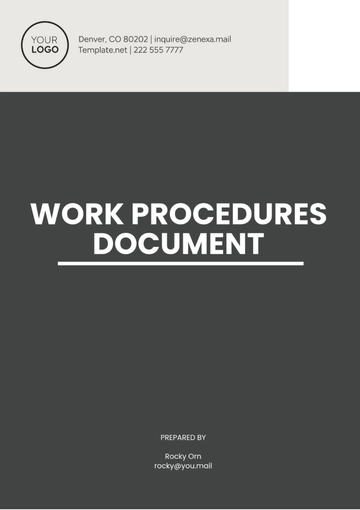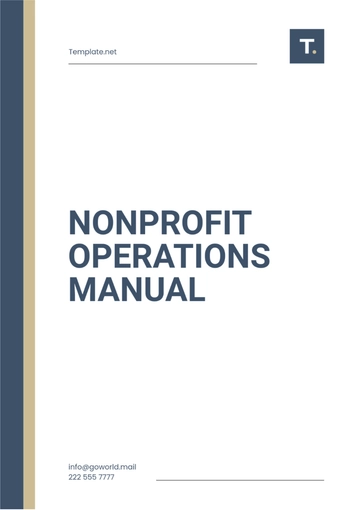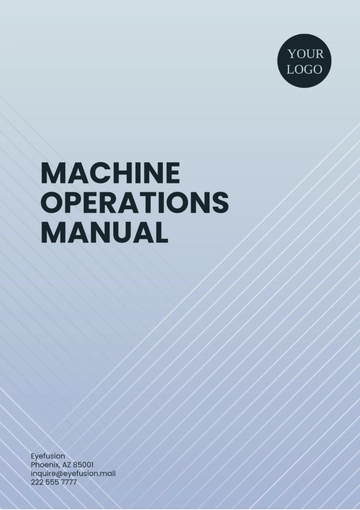Free Nonprofit Board Manual

Nonprofit Board Manual
Employee Information | |
|---|---|
Name: | [YOUR NAME] |
Company: | [YOUR COMPANY NAME] |
Department: | [YOUR DEPARTMENT] |
Date: | [DATE] |
I. Introduction
Welcome to the [YOUR NONPROFIT ORGANIZATION] Board Manual. This manual is designed to provide comprehensive guidance and resources for board members to effectively fulfil their roles and responsibilities within the organization.
A. Purpose
The purpose of this manual is to outline the essential information, policies, and procedures governing the operation of the board and its interactions with the organization. It serves as a reference guide for board members to navigate their duties and contribute to the success of [YOUR NONPROFIT ORGANIZATION].
B. Mission Statement
[YOUR NONPROFIT ORGANIZATION]'s mission is to [insert mission statement here]. As board members, it is imperative to align with this mission and work collaboratively towards its fulfillment.
II. Governance Structure
The governance structure of [YOUR NONPROFIT ORGANIZATION] is designed to ensure transparency, accountability, and effective decision-making.
A. Board Composition
The board is composed of [number] dedicated individuals who bring diverse expertise and perspectives to the organization. Board members are selected based on their commitment to the mission of [YOUR NONPROFIT ORGANIZATION] and their ability to contribute effectively to its goals.
B. Roles and Responsibilities
Each board member is expected to adhere to their specific roles and responsibilities, as outlined in the following table:
Name | Company Name | Department | Date |
|---|---|---|---|
[YOUR NAME] | [YOUR COMPANY NAME] | [YOUR DEPARTMENT] | [DATE] |
[Board Member 1] | [COMPANY NAME] | [DEPARTMENT] | [DATE] |
[Board Member 2] | [COMPANY NAME] | [DEPARTMENT] | [DATE] |
[Board Member 3] | [COMPANY NAME] | [DEPARTMENT] | [DATE] |
[Board Member 4] | [COMPANY NAME] | [DEPARTMENT] | [DATE] |
III. Meetings and Communication
Regular meetings are essential for effective communication, decision-making, and progress tracking within the organization.
A. Board Meetings
Board meetings are held [FREQUENCY] and provide an opportunity for board members to discuss strategic initiatives, review financial reports, and make important decisions regarding the organization's direction. Agendas and meeting minutes are circulated in advance to ensure productive discussions.
B. Communication Channels
[YOUR NONPROFIT ORGANIZATION] utilizes various communication channels, including email, phone calls, and virtual meetings, to keep board members informed about important updates, announcements, and urgent matters.
IV. Financial Oversight
Ensuring the financial stability and sustainability of [YOUR NONPROFIT ORGANIZATION]is a crucial responsibility of the board.
A. Budget Approval
The board is responsible for reviewing and approving the annual budget, which outlines the organization's anticipated income and expenses for the fiscal year. Budgetary decisions should align with the organization's strategic priorities and mission.
B. Financial Reporting
Regular financial reports are provided to the board, detailing the organization's financial performance, including income, expenses, assets, and liabilities. Board members are expected to review these reports carefully and raise any questions or concerns as needed.
V. Board Development and Evaluation
Continuous learning and improvement are essential for maintaining the effectiveness and relevance of the board.
A. Orientation and Training
New board members undergo a comprehensive orientation process to familiarize themselves with [YOUR NONPROFIT ORGANIZATION]'s mission, policies, procedures, and governance structure. Additionally, ongoing training opportunities are provided to enhance board members' skills and knowledge.
B. Performance Evaluation
Regular evaluations are conducted to assess the performance of individual board members, as well as the overall effectiveness of the board. Feedback collected from evaluations is used to identify areas for improvement and inform future development initiatives.
VI. Conclusion
In conclusion, [YOUR NONPROFIT ORGANIZATION]'s Board Manual serves as a valuable resource for board members to fulfil their responsibilities effectively and contribute to the organization's success. By adhering to the guidelines outlined in this manual, board members can work collaboratively towards advancing the mission and vision of [YOUR NONPROFIT ORGANIZATION].
- 100% Customizable, free editor
- Access 1 Million+ Templates, photo’s & graphics
- Download or share as a template
- Click and replace photos, graphics, text, backgrounds
- Resize, crop, AI write & more
- Access advanced editor
Discover the ultimate solution for nonprofit boards with Template.net's Nonprofit Board Manual Template. Crafted for efficiency, it's fully editable and customizable to suit your organization's unique needs. With seamless integration into our Ai Editor Tool, streamline your processes effortlessly. Elevate your governance with this essential resource.





























